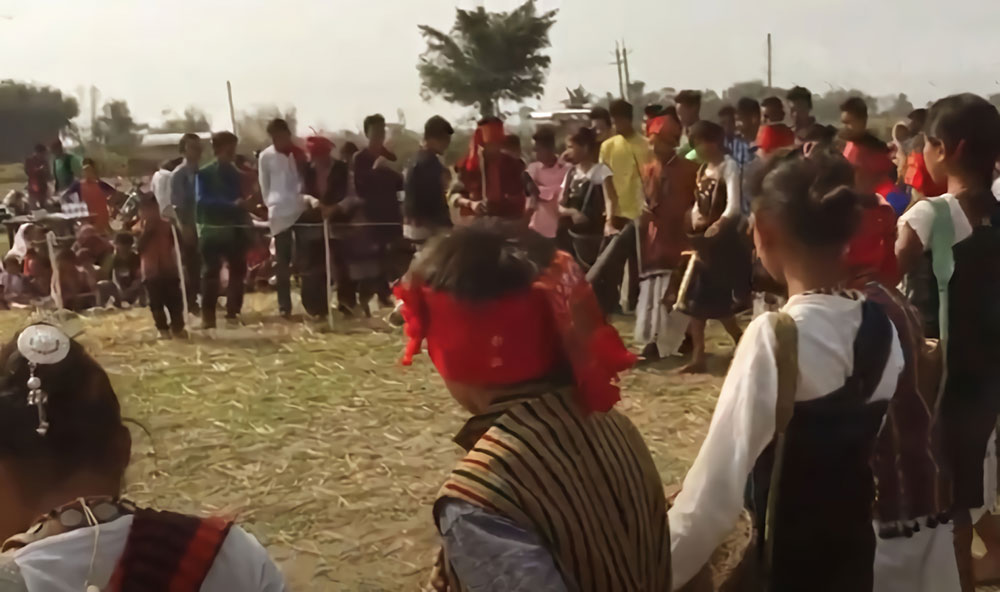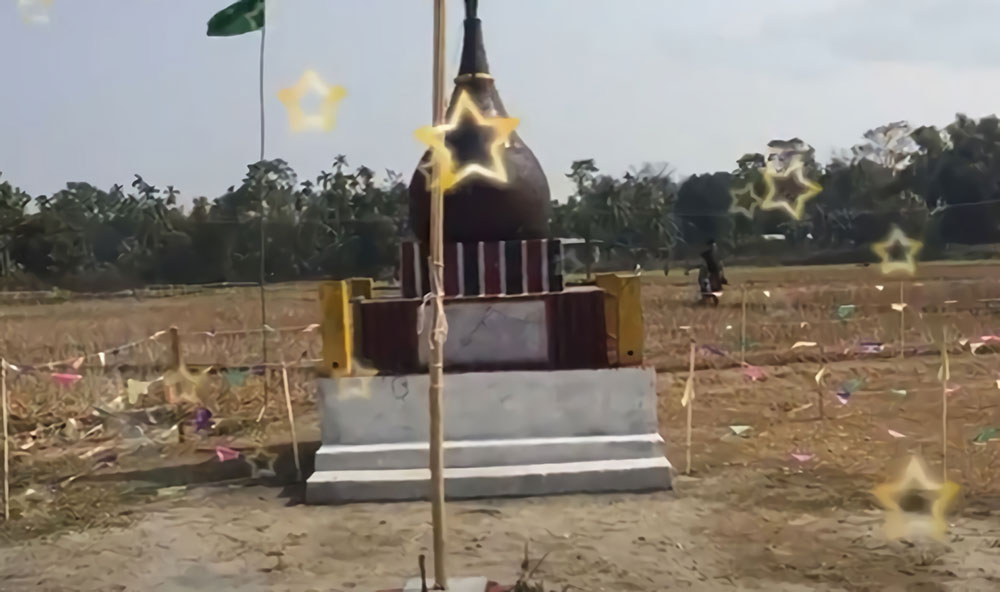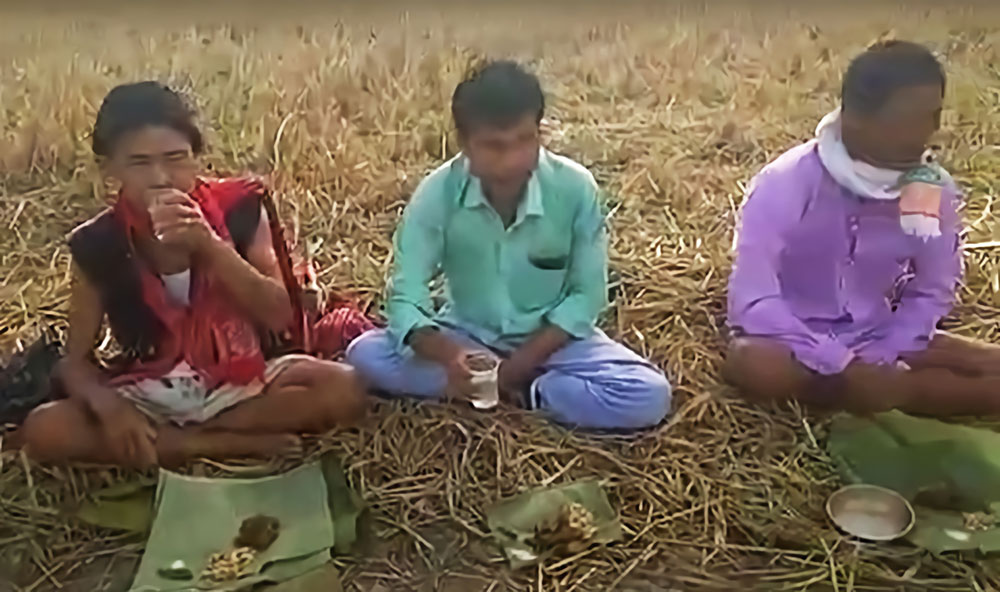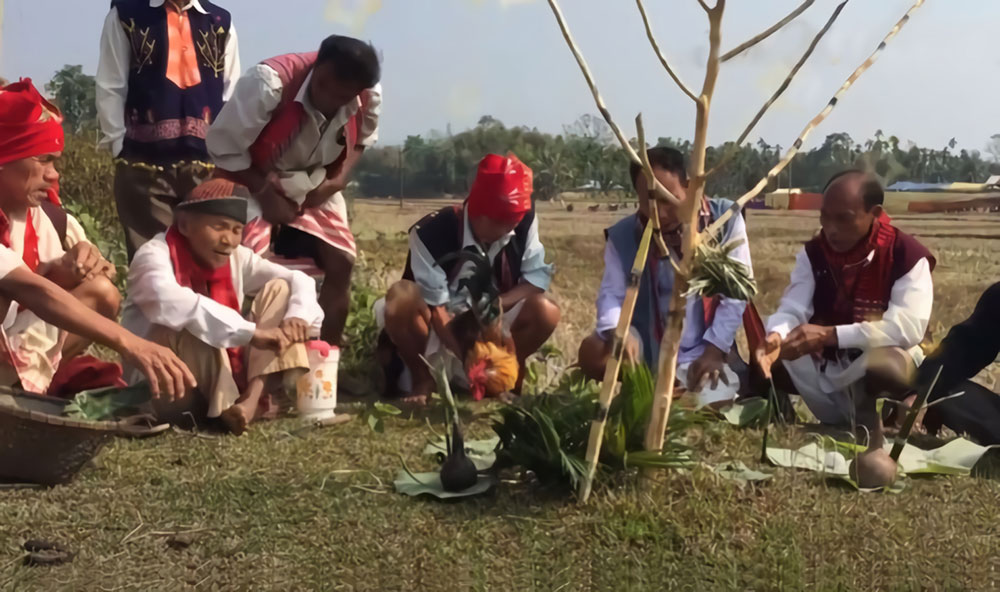
Rongker Festival is observed by the Karbis of Meghalaya and Assam in India.
TIME:
Rongker is an annual winter time festival.
ETYMOLOGY:
‘Rongker’ is also known as ‘Dehal’ in Ri-Bhoi District of Meghalaya and Kamrup Metropolitan District (‘Dumra Longri’ in Karbi language) in Assam.
PURPOSE:

- Rongker Festival is celebrated to appease the local deities.
- This festival of merriment is celebrated for three prime purposes.
- It is observed to seek blessings from the local deities for a bountiful harvest of crops, rid the villagers of all omen and evil happenings, as well as for welfare of the villagers.
DURATION
The Rongker celebration is held for three days.
THE SITE SETUP
The set-up of the Rongker prayer site is prepared with utmost respect and attention to details.
THE TEN EARTHEN ALTARS
At the Rongker prayer site, the Karbis set up ten earthen altars.
Each of these 10 earthen shrines is dedicated to the 10 of the 12 deities of the Karbis.
DIRECTION OF THE TEN EARTHEN ALTARS
These 10 earthen altars are installed on the eastern side of the site where Rongker is to be observed.
CONSTRUCTION OF THE ALTARS
The altars of Rongker are constructed in a row. They are placed heading the south-north direction. The 10 earthen altars are christened after the deities.
SHAPE OF THE ALTARS
The 10 earthen altars are shaped in such a way so that the respective deities are able to rest comfortably there.
WHY ONLY 10 EARTHEN ALTARS
There is a reason as to why only 10 earthen altars are constructed whereas in the Karbi pantheon of deities there are 12 deities.
This reason is that the Karbis deem the two deities – Hemphu, and Rasinja – as siblings (brother and sister).
On the other hand, the deity – Mukrang – is the husband of Rasinja. Therefore, the sibling deities Hemphu, and Rasinja as well as the deity Mukrang share a common shrine.
THE GOURD & RICE BEER

For observing Rongker Festival, the Karbi priests choose 10 gourds with tapering mouths. The 10 gourds are filled with the first-made rice beer. Then the rice beer- filled gourds are placed on the Rongker altars. Each rice beer-filled gourd is offered in the name of the respective gods.
VARIOUS ITEMS USED DURING RONGKER
Mentionably, nothing else except the gourd (full of rice beer), is placed on the altars.
EXCEPTIONS:
However, branches and leaves of particular plants and a tree are utilised while constructing the altars of Rongker deities.
For instance, bamboo are placed on the altar of Ningding Sarpo. Similarly, the Karbi priests erect a few bamboo sticks and also place some branches of Basil on the altar dedicated to the deity, Murti.
On the altar of Arlok, the Karbi priests place a branch of Fongrong (a locally available tree who’s branches are deemed holy).
THE RONGKER RITUALS:
The Karbi priests observe various rituals while observing the Rongker celebrations in the four parts of ‘Sadi’, ‘Karkli’, ‘Kurusar, and Rongphu-Rongling-Kangthin.
SADI
In the ‘Sadi’ process, the Karbi priests invoke all the 12 deities.
KARKLI
While performing the ‘Karkli’ process of Ronger celebrations, the Karbi priests worship the Karbi deities in two methods.
These two worshiping methods are known as ‘Kibo-kaba’ and ‘Koi-abida’.
In the first worshipping manner of ‘Kibo-kaba’ while performing ‘Karkli during the Rongker celebrations, the Karbi priests offer meal to the Karbi deities. On the other hand, while performing the ‘Karkli manner of worshipping during the Rongker celebrations, the Karbi priests offer areca nuts and betel-leaves to the deities.
Mentionably, the entire man folk of a Karbi village participate during these ‘Karkli’ celebration during Rongker.
It is the duty of all males of each Karbi hamlet to bring all the required items to the site where the Rongker generations are to be held.
The male folk of the Karbi villages gather at the predetermined site of Rongker festivities in the morning. Then, each of them deposit the articles with the appointed person at the Rongker site.
KURUSAR
The ‘Kurusar’ is the main priest of the Karbis.
Hence during the Rongker festivities, the principal task is performed by the main Karbi priest.
Of course, the ‘Kurusar is assisted by a number of other specialists adept in the Karbi religious rite and rituals.
THE RONGKER SPECIALISTS:
During the Rongker festivities, the ‘Kurusar’ plays a very prominent role.
Besides the ‘Kurusar’, the other specialists of Karbi religion are the Gaon Burah (village headman), the group known as ‘Thek-kere’ (elderly villagers who are versed in the processes of worshipping the Karbi deities), the youth leader, and an official of the Karbi Kingdom.
THE PURIFICATION PROCESS:
Notably, it is not necessary that one must take bath before performing the Rongker rituals.
However, each person must be purified. This is done in a special manner.
The purification process involves sprinkling of water with basil leaves – deemed sacred.
THE KARBIS:
The Karbis are a patrilineal society. They are composed of five major clans or Kur. They are Engti (Lijang), Terang (Hanjang), Enghee (Ejang), Teron (Kronjang), and Timung. The five clans have a number of sub-clans.
SACRIFICES DONE DURING RONGKER:
During the Rongker celebrations, the Karbi community offers sacrifices to their deities.
THE SACRIFICES:
The Karbis offer sacrifices on each of the three nights of Rongker. These are elaborated.
BAMUN
The Karbi deity, Bamun, is vegetarian. Hence, no sacrifice is offered to Bamun during Rongker.
Except Bamun, sacrifices are offered to all the other deities during the Rongker celebrations.
POST-SACRIFICE RITUALS:
After the sacrifices are offered to the deities during Rongker, the religious specialists (thek-kere) predicts the future of the villagers.
They do this by looking at the intestines and hearts of the animals that were sacrificed.
Once the Rongker rituals are over, the villagers have a feast.
THE SECOND NIGHT OF RONGKER:
On the second night of Rongker, a ritual known as ‘Ajo-Rongker’ or ‘Rongphu-Rongling-Kangthin’ is performed.
Dancing takes place to chase the evil spirits for all sides of the village. Then, an altar is constructed. It is made at the last portion of the village road.
Finally, they sacrifice a chicken at the altar. This sacrifice is made in the name of ‘Ajo-Angtarpi’.
THE THIRD NIGHT OF RONGKER:

On the concluding and third night of Rongker Festival, the Karbis sacrifice a cock to the tiger deity – ‘Arnam-teke’.
This is performed on an altar that was constructed earlier beside a ghat.
The sacrifice is made seeking protection from the deity against tigers that may attack the village.
The writer — Nilutpal Gogoi is an entrepreneur, senior journalist, writer, translator (from Assamese to English & vice versa), avid traveller, British English Accent & grammar trainer, educationist, and martial arts (Taekwondo) practitioner.
